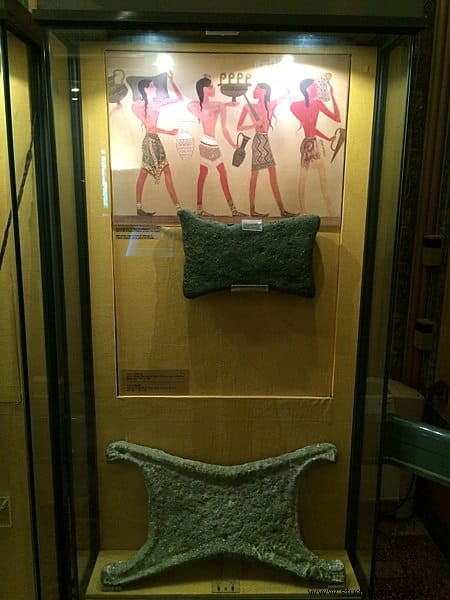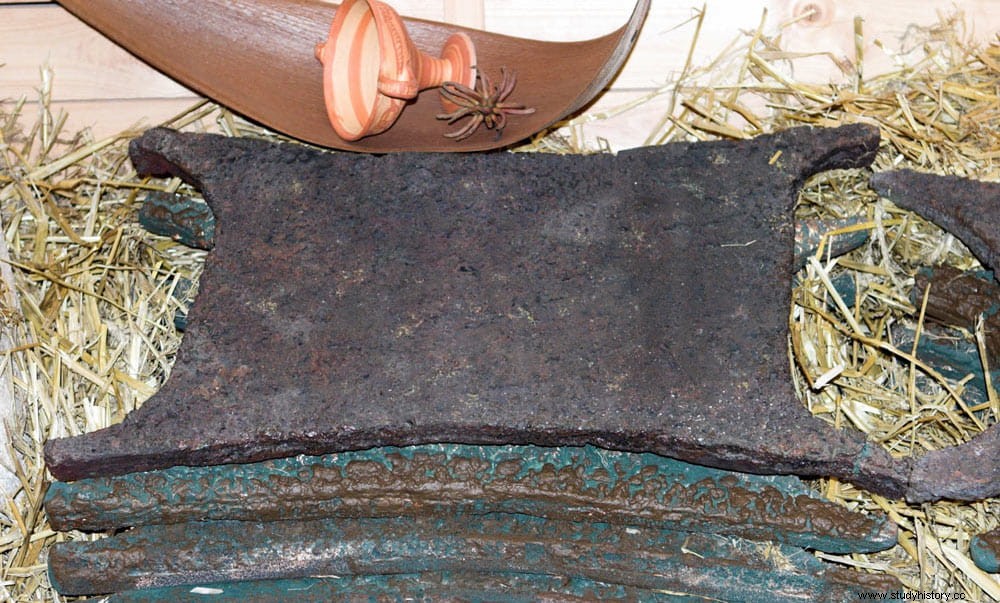The oxhide ingots (in English known as oxhide ingots ) are metal plates mainly made of copper, although sometimes also made of tin, which were produced during the Late Bronze Age on the island of Cyprus and were later distributed throughout the Mediterranean.
They were used, at least from the year 1500 BC, as a means of transporting copper and selling it in bulk throughout the Mediterranean by sea, and its use disappeared around the year 1000 BC

Its shape resembles the skin of an ox with a protruding handle or handle on each of its corners, which is why they are called that, although the name they originally had is unknown.
The shape was thought to indicate that the value of each ingot was roughly the equivalent of an ox, but today experts agree that this is just a coincidence and that the shape responds more to criteria of ease of transport.
Some researchers such as Cemal Pulak believe that they may have served as a type of primitive currency. In this sense, the ingots found in some wrecks (sunken ships) of the time are similar enough as to have allowed a approximate but rapid calculation of a certain amount of raw metal . However, the weights of the ingots vary from one find to another, and this seems to indicate that they cannot be considered as currency.
Archaeologists have recovered many ingots of this type, mainly from two shipwrecks off the coast of Turkey:that of the Uluburun, to which we have already devoted the article The fantastic cargo of the Uluburun, a Bronze Age ship of uncertain origin, and another at Cape Gelidonya.
The Uluburun contained 317 copper ingots in their normal oxhide form, 36 with only two protrusions at the corners, 121 in the form of buns, and five in the form of a pillow. The weight of these ingots ranges from 20.1 to 29.5 kg after being cleaned of corrosion. They were found stacked in four rows following a herringbone pattern. In addition to metal ingots, the cargo included ivory, jewelry, and Mycenaean, Cypriot, and Canaanite pottery.

The wood transported by the Uluburun corresponded to trees cut between 1316 and 1305 BC. according to the study of her rings, which indicates that this may be the date of her last voyage and sinking. This is corroborated by the Mycenaean pottery found on board, which corresponds to that found at the level of the destruction of Miletus by the Hittite king Mursili II, which occurred in 1312 BC.
The Cape Gelidonya shipwreck contained 34 oxhide ingots as well as numerous honeycomb ingots, rectangular tin bars, and Cypriot agricultural tools made of bronze. Radiocarbon dating of the wood carried by the ship gives an approximate date of 1200 BC
A mold for casting ox skin ingots was found at the Ras Ibn Hani archaeological site in Syria. , made from a type of fine-grained limestone.

The importance of these ingots in the Mediterranean and particularly Cypriot economy is evident from the fact that, during the Late Bronze Age, Cyprus produced numerous bronze supports that included figurines representing a man carrying an ingot. ox skin . The ingots show the typical shape of four protruding handles, and the men carry them on their shoulders. According to Vassos Karageorghis and George Papasavvas, these artifacts are among the most impressive metallic objects produced in the Eastern Mediterranean .
Although only a fragment of oxhide ingot has been found in Egypt, there are numerous painted scenes showing representations of men carrying this type of ingot. The oldest dates back to the 15th century BC. and the most recent from the 12th century B.C. The ingots show their typical four bumps, and red paint remains on them (suggesting they were depicted as being made of copper).
The inscriptions that accompany the paintings explain that the men who brought the ingots came from the north, specifically from Retenu (the name that the Egyptians gave to the regions of Palestine and Syria) and Keftiu (Caphtor, a disputed location).

A relief from Karnak depicts Pharaoh Amenhotep II riding a chariot and shooting arrows at an oxhide ingot. , who already has another 5 dunks. It refers to one of the pharaoh's greatest athletic achievements:shooting arrows at a copper ingot while driving a chariot with the reins tied around his waist.
Shooting arrows at copper ingots was one of the favorite sports of the pharaohs at that time.

Other representations of people carrying them as tribute are found on the obelisk of Rassam (Ashurnasirpal II), the throne pedestal of Shalmaneser III with representations of Syrian tributaries, and a painting from a tomb in Thebes, where a person carries an ingot to the shoulder and in hand a Minoan-type vase.

In 1963, excavations at Enkomi, a Bronze Age site in the north-western part of Cyprus, found a bronze statuette, about 35 centimeters high, representing a god who has been called ingot god . He carries a spear and a small shield and stands on a base in the shape of an ox hide, exactly like the one on the copper ingots. He is a divinity of Syrian-Palestinian origin, a god of the tempest or storm, but also of the genetic and fertilizing force that is identified with the ox or bull.
In the 1980s, another statuette of a divinity was found, this time female and from the 12th century BC, arranged on an ox skin ingot. , and whom she identified as the fertility goddess of the copper mines.
As Vassos Karageorghis and George Papasavvas say:Apparently no one warned the ancient world to beware of Cypriots carrying bullion. So Cypriots continued to carry their ingots at home and abroad, and Cypriot blacksmiths continued to represent some of them in action.
